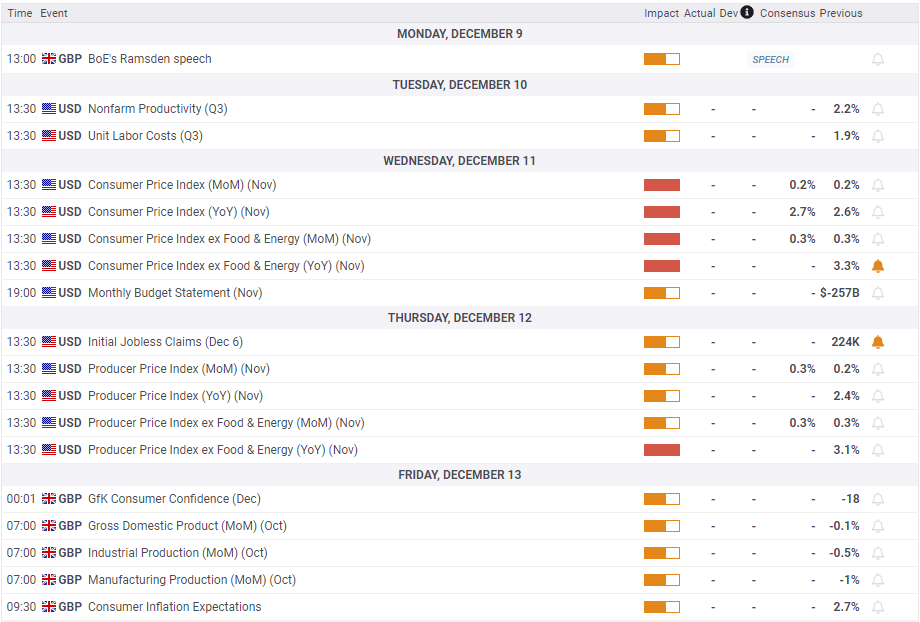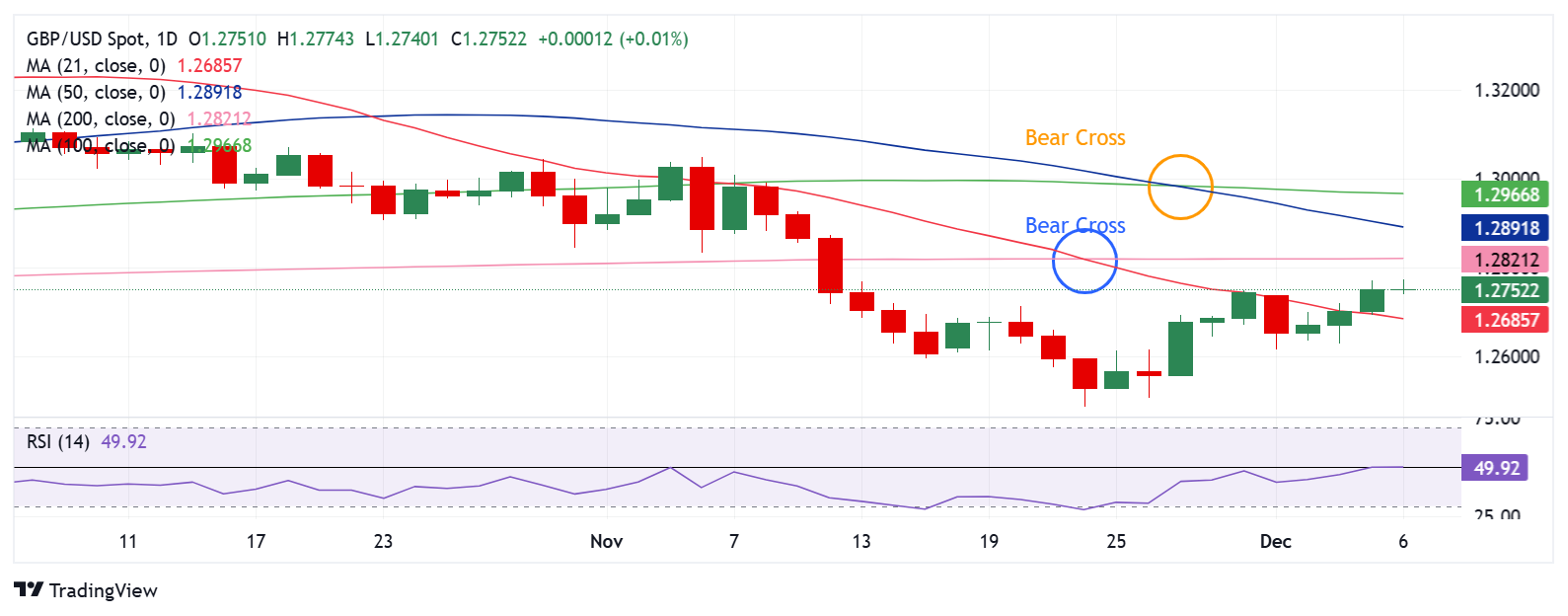- The Pound Sterling hit three-week highs against the US Dollar above 1.2750.
- GBP/USD awaits US inflation data amid a relatively data-light week ahead.
- Bearish bias intact while the Pound Sterling holds below the key 200-day SMA.
The Pound Sterling (GBP) held on to the corrective upside against the US Dollar (USD), fuelling a brief GBP/USD recovery above the 1.2750 barrier.
Pound Sterling stood resilient to persistent USD demand
Political turbulence in South Korea and France, US President-elect Donald Trump’s tariff threats, and the diverging monetary policy outlooks between the US Federal Reserve (Fed) and the Bank of England (BoE) emerged as the main drivers for the GBP/USD price action.
On Monday, the pair started the week negatively, tumbling over a big figure to hit weekly lows at 1.2617. Since then, Pound Sterling buyers fought back control and resumed the previous week’s recovery to reach the highest level in three weeks above 1.2750.
Trump threatened on Saturday that he would impose 100% tariffs on BRICS nations if they tried to replace the USD with their own. Mounting tariff war fears fuelled risk-aversion across the financial markets, reviving the demand for the Greenback as a safe-haven asset while weighing on risk currencies such as the British Pound.
However, sustained bets for a 25 basis points (bps) Fed interest rate cut in December remained a drag on the US Dollar despite Chairman Jerome Powell’s prudent remarks. Markets price in a 70% chance of such a move later this month, the CME Group’s FedWatch Tool shows, at the press time.
Powell said in his speech at the New York Times' DealBook Summit, “growth is definitely stronger than we thought, and inflation is coming a little higher. The good news is that we can afford to be a little more cautious as we try to find neutral," he added, referring to the neutral interest rate.
A series of US economic data releases, including the ISM surveys, JOLTS Job Openings and the ADP Employment Change, came in mixed and failed to alter the market’s expectations of a rate cut this month, limiting the Greenback’s upside attempts.
That said, the USD stayed underpinned by the market’s nervousness amid looming geopolitical and trade war risks and ahead of the all-important US Nonfarm Payrolls data release.
On the other side, the Pound Sterling regained traction, paying little heed to the dovish comments from BoE Governor Andrew Bailey on Wednesday. In a pre-recorded interview with the Financial Times (FT), Bailey said that “he expects four UK rate cuts next year as inflation eases.”
Heading into the weekend, GBP/USD consolidated at multi-week highs, anticipating the key US labor data for a fresh directional impetus.
Following the 36,000 increase recorded in October, the US Bureau of Labor Statistics announced on Friday that Nonfarm Payrolls (NFP) rose by 227,000 in November. This print came in above the market expectation of 200,000 but failed to boost the USD, helping GBP/USD cling to its weekly gains. Other details of the jobs report showed that the Unemployment Rate edged higher to 4.2%, while the annual wage inflation held steady at 4%.
The week ahead: All eyes on US CPI inflation
It’s a mediocre week from the point of view of macroeconomic news, with the US Consumer Price Index (CPI) data likely to stand out.
The first two trading days of the week have little to no top-tier economic publications from both sides of the Atlantic until the US inflation report drops on Wednesday.
However, China’s inflation data could stir markets amid mounting concerns about an economic slowdown, impacting risk sentiment and high-beta currencies such as the British Pound.
Thursday will feature the US Producer Price Index (PPI) data, while the UK monthly Gross Domestic Product (GDP) and industrial figures will feature on Friday.
It will be dry in terms of Fedspeak as the Fed enters its ‘blackout period’ on Saturday ahead of the December 17-18 policy meeting.
That said, geopolitical developments and US-Sino trade updates will be closely followed.
GBP/USD: Technical Outlook
From a short-term technical outlook, sellers will likely retain control if GBP/USD holds below the 200-day Simple Moving Average (SMA) at 1.2821.
Adding credence to the negative outlook, the pair charted dual Bear Crosses a week ago.
However, the 14-day Relative Strength Index (RSI) has recovered to the 50 level from the negative territory, suggesting that the rebound could extend before the next leg down.
The Pound Sterling needs a sustained break above the 200-day SMA at 1.2821 to sustain the recovery.
The next substantial contention area aligns near 1.2900, the confluence of the round figure and the 50-day SMA.
Further up, the 100-day SMA at 1.2967 could challenge the bearish commitments.
On the downside, the immediate support aligns at the 21-day SMA at 1.2685, below which the week low of 1.2617 will be tested.
Additional declines will threaten the six-month low of 1.2488.
Information on these pages contains forward-looking statements that involve risks and uncertainties. Markets and instruments profiled on this page are for informational purposes only and should not in any way come across as a recommendation to buy or sell in these assets. You should do your own thorough research before making any investment decisions. FXStreet does not in any way guarantee that this information is free from mistakes, errors, or material misstatements. It also does not guarantee that this information is of a timely nature. Investing in Open Markets involves a great deal of risk, including the loss of all or a portion of your investment, as well as emotional distress. All risks, losses and costs associated with investing, including total loss of principal, are your responsibility. The views and opinions expressed in this article are those of the authors and do not necessarily reflect the official policy or position of FXStreet nor its advertisers. The author will not be held responsible for information that is found at the end of links posted on this page.
If not otherwise explicitly mentioned in the body of the article, at the time of writing, the author has no position in any stock mentioned in this article and no business relationship with any company mentioned. The author has not received compensation for writing this article, other than from FXStreet.
FXStreet and the author do not provide personalized recommendations. The author makes no representations as to the accuracy, completeness, or suitability of this information. FXStreet and the author will not be liable for any errors, omissions or any losses, injuries or damages arising from this information and its display or use. Errors and omissions excepted.
The author and FXStreet are not registered investment advisors and nothing in this article is intended to be investment advice.
Recommended Content
Editors’ Picks

EUR/USD declines below 1.0300 ahead of US data
EUR/USD stays under heavy selling pressure and trades below 1.0300 on Wednesday. News of US President-elect Donald Trump planning to declare an economic emergency to allow for a new tariff plan weighs on risk mood and boosts the USD ahead of key data releases.

GBP/USD drops to fresh multi-month lows below 1.2400
GBP/USD remains on the back foot and trades at its weakest level since April below 1.2400. The risk-averse market atmosphere on growing concerns over an aggressive tariff policy by President-elect Donald Trump drags the pair lower as focus shifts to US data.

Gold stabilizes near $2,650; upside seems limited ahead of FOMC Minutes
Gold price (XAU/USD) fluctuates in a narrow range at around $2,650 on Wednesday. The benchmark 10-year US Treasury bond yield holds at its highest level since late April near 4.7%, making it difficult for XAU/USD ahead of FOMC Minutes.

ADP Employment Change expected to show modest slowdown in December
The ADP Employment Change report for December will be released on Wednesday at 13:15 GMT. It’s expected to show that the US private sector added 140K new jobs after gaining 146K in November.

Five fundamentals for the week: Nonfarm Payrolls to keep traders on edge in first full week of 2025 Premium
Did the US economy enjoy a strong finish to 2024? That is the question in the first full week of trading in 2025. The all-important NFP stand out, but a look at the Federal Reserve and the Chinese economy is also of interest.

Best Forex Brokers with Low Spreads
VERIFIED Low spreads are crucial for reducing trading costs. Explore top Forex brokers offering competitive spreads and high leverage. Compare options for EUR/USD, GBP/USD, USD/JPY, and Gold.

